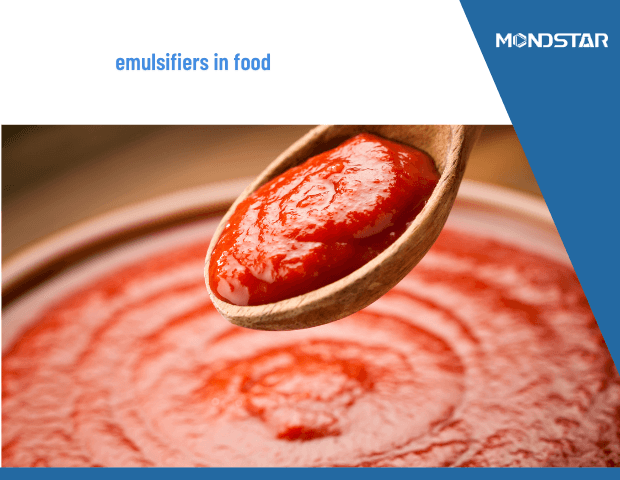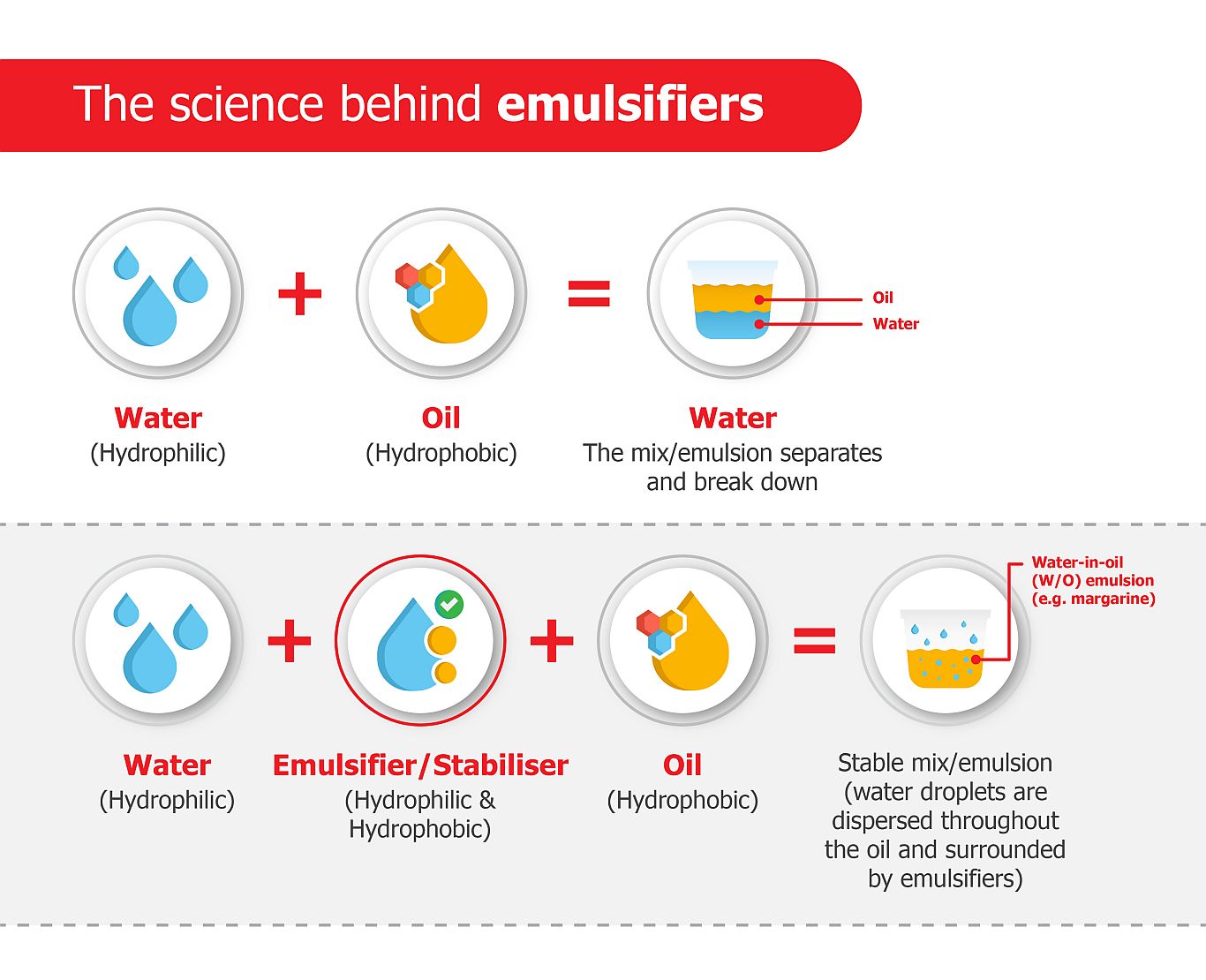Uncover the Advantages of Making Use Of an Emulsifier in Food for Boosted Culinary Experiences
Emulsifiers are frequently neglected yet vital elements in culinary methods. They help with the blending of disparate active ingredients, boosting both flavor and texture. By ensuring stability, emulsifiers avoid the unsightly separation of mixes. Their flexibility spans different applications, from sauces to dressings. Comprehending their feature can cause substantial enhancements in food high quality and presentation. What particular benefits do emulsifiers supply that can transform day-to-day recipes right into phenomenal cooking experiences?
Understanding Emulsifiers: What They Are and How They Work
Emulsifiers play an important duty in the food market, working as agents that help with the blending of water and oil, two materials that commonly do not mix. These compounds have both hydrophilic (water-attracting) and hydrophobic (oil-attracting) buildings, enabling them to stabilize blends by decreasing the surface area tension in between both stages. Common emulsifiers consist of lecithin, mono- and diglycerides, and certain healthy proteins.
When included in food, emulsifiers develop a steady solution, avoiding splitting up and guaranteeing a consistent structure - Emulsifier In Food. They are vital in lots of applications, ranging from salad dressings and mayonnaise to gelato and sauces. By maintaining the honesty of blends, emulsifiers not only improve the visual charm of food yet also enhance mouthfeel and consistency. Their capability to maintain emulsions makes them crucial in modern food formula, contributing substantially to the high quality and life span of numerous products
The Function of Emulsifiers in Flavor Enhancement
While often forgotten, emulsifiers significantly add to taste enhancement in foodstuff. They play a necessary role in improving the general preference experience by guaranteeing that flavor compounds are evenly dispersed throughout a meal. By stabilizing emulsions, such as dressings or sauces, emulsifiers protect against the separation of oil and water, permitting flavors to meld with each other much more successfully. This consistent circulation not just magnifies the preference yet additionally assures that each bite is consistently tasty.
Emulsifiers can enhance the assumption of particular tastes, making them extra obvious on the taste. They might engage with particular components, assisting to release volatile flavor substances that contribute to a meal's aromatic account. The use of emulsifiers can substantially boost the culinary experience, transforming simple recipes into facility and fascinating flavor journeys. Their refined yet impactful function in flavor improvement ought to not be undervalued in the art of food preparation.
Emulsifiers and Appearance: Creating Creamy and Velvety Cuisines
The influence of emulsifiers extends beyond flavor enhancement to the domain of structure, where they contribute in creating luscious and velvety recipes. By facilitating the consistent distribution of fats and water, emulsifiers make it possible for the development of steady emulsions, leading to an extravagant mouthfeel. This is particularly obvious in items like mayonnaise, sauces, and dressings, where a smooth, luscious uniformity is wanted.
Emulsifiers such as lecithin and mono- and diglycerides function to reduce surface area stress in between ingredients, allowing for an unified blend that boosts the sensory experience. The luscious appearance attained through emulsification can raise meals, making them a lot more delightful and appealing. In addition, the capacity to create a velvety appearance enables chefs to incorporate numerous active ingredients without jeopardizing uniformity, leading to cutting-edge culinary developments. Basically, emulsifiers play a vital check my reference role in changing ordinary dishes right into remarkable culinary experiences with appearance improvement.
Stability Matters: Just How Emulsifiers Prevent Separation
A critical aspect of cooking emulsifiers is their capacity to stop separation, making sure that items maintain their intended texture and look over time. Emulsifiers work by supporting mixes of oil and water, which normally tend to separate because of differences in density and polarity. By reducing surface area stress at the oil-water user interface, emulsifiers assist in the development of stable emulsions, enabling for an uniform circulation of active ingredients.

Usual Emulsifiers in Cooking and Their Applications
Recognizing the various emulsifiers commonly utilized in food preparation exposes their significant duties in enhancing food texture and security. Lecithin, acquired from egg yolks or soybeans, is commonly utilized in mayonnaise and salad dressings, offering a luscious uniformity. Mustard, also an emulsifier, help in stabilizing vinaigrettes while imparting taste.


Another prominent emulsifier is xanthan periodontal, regularly made use of in gluten-free baking and sauces for its thickening properties. Guar periodontal offers a comparable objective, boosting the structure of gelato and milk items.
Mono- and diglycerides, usually located in refined foods, help improve life span and keep appearance. Finally, casein, a milk healthy protein, is utilized in cheese-making and luscious sauces, adding to a smooth mouthfeel. Each of these emulsifiers plays a necessary function in cooking applications, guaranteeing preferable appearances and protecting against splitting up in diverse foodstuff.
Often Asked Concerns
Are Emulsifiers Safe for People With Food Allergies?
Emulsifiers can be risk-free for people with food allergies, relying on the details emulsifier utilized. It is necessary to identify the resource of the emulsifier, as some may cause sensitive responses in sensitive people.
Exactly How Do Emulsifiers Affect the Nutritional Web Content of Food?
Emulsifiers can affect the dietary material of food by improving nutrition absorption and boosting texture. Nonetheless, their visibility might additionally thin down specific nutrients, relying on the food matrix, possibly changing general nutritional worth.
Can Emulsifiers Be Utilized in Vegan Food Preparation?
Emulsifiers can be properly made use of in vegan food preparation, supplying appearance and stability to meals. Plant-based emulsifiers like lecithin, stemmed from soy or sunflower, assistance blend ingredients, enhancing the total high quality see here now of vegan culinary productions.
What Are the Ecological Influences of Emulsifier Manufacturing?
The ecological influences of emulsifier production commonly consist of logging, water air pollution, and high power intake. Additionally, some resources of emulsifiers can contribute to biodiversity loss, increasing worries concerning sustainability in food manufacturing techniques.
Just How Do Emulsifiers Contrast to All-natural Thickeners in Cooking?
Emulsifiers use smoother structures and enhanced stability compared to natural thickeners, which can impart distinctive tastes - Emulsifier In Food. While emulsifiers enhance mouthfeel and appearance, all-natural thickeners provide more wellness benefits and can add to the meal's taste account
When added to food items, emulsifiers produce a stable solution, stopping separation and making certain an uniform appearance. While usually ignored, emulsifiers significantly contribute to flavor enhancement in food items. Understanding the different emulsifiers frequently made use of in cooking reveals their significant duties in enhancing food texture and security. Emulsifiers can be safe for individuals with food allergic reactions, depending on the particular emulsifier utilized. Emulsifiers can affect the nutritional material of food by boosting nutrition absorption and improving texture.